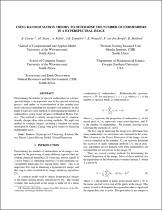 ResearchSpace
ResearchSpace
Using random matrix theory to determine the number of endmembers in a hyperspectral image
JavaScript is disabled for your browser. Some features of this site may not work without it.
- ResearchSpace
- →
- Research Publications/Outputs
- →
- Conference Publications
- →
- View Item
| dc.contributor.author |
Cawse, K

|
|
| dc.contributor.author |
Sears, M

|
|
| dc.contributor.author |
Robin, A

|
|
| dc.contributor.author |
Damelin, SB

|
|
| dc.contributor.author |
Wessels, Konrad J

|
|
| dc.contributor.author |
Van den Bergh, F

|
|
| dc.contributor.author |
Mathieu, Renaud SA

|
|
| dc.date.accessioned | 2010-07-13T08:40:54Z | |
| dc.date.available | 2010-07-13T08:40:54Z | |
| dc.date.issued | 2010-06 | |
| dc.identifier.citation | Cawse, K, Sears, M, Robin, A et al. 2010. Using random matrix theory to determine the number of endmembers in a hyperspectral image. The 2nd Workshop in Hyperspectral Image and Signal Processing: Evolution in Remote Sensing (WHISPERS). 14-16 June 2010, Reykjavik, Iceland, pp 4 | en |
| dc.identifier.uri | http://hdl.handle.net/10204/4062 | |
| dc.description | The 2nd Workshop in Hyperspectral Image and Signal Processing: Evolution in Remote Sensing (WHISPERS). 14-16 June 2010, Reykjavik, Iceland | en |
| dc.description.abstract | Determining the number of spectral endmembers in a hyperspectral image is an important step in the spectral unmixing process, and under- or overestimation of this number may lead to incorrect unmixing for unsupervised methods. In this paper we discuss a new method for determining the number of endmembers, using recent advances in Random Matrix Theory. This method is entirely unsupervised and is computationally cheaper than other existing methods. We apply our method to synthetic images, including a standard test image developed by Chein-I Chang, with good results for Gaussian independent noise | en |
| dc.language.iso | en | en |
| dc.subject | Hyperspectral unmixing | en |
| dc.subject | Random matrix theory | en |
| dc.subject | Linear mixture model | en |
| dc.subject | Virtual dimension | en |
| dc.subject | Signal processing | en |
| dc.subject | Remote sensing | en |
| dc.title | Using random matrix theory to determine the number of endmembers in a hyperspectral image | en |
| dc.type | Conference Presentation | en |
| dc.identifier.apacitation | Cawse, K., Sears, M., Robin, A., Damelin, S., Wessels, K. J., Van den Bergh, F., & Mathieu, R. S. (2010). Using random matrix theory to determine the number of endmembers in a hyperspectral image. http://hdl.handle.net/10204/4062 | en_ZA |
| dc.identifier.chicagocitation | Cawse, K, M Sears, A Robin, SB Damelin, Konrad J Wessels, F Van den Bergh, and Renaud SA Mathieu. "Using random matrix theory to determine the number of endmembers in a hyperspectral image." (2010): http://hdl.handle.net/10204/4062 | en_ZA |
| dc.identifier.vancouvercitation | Cawse K, Sears M, Robin A, Damelin S, Wessels KJ, Van den Bergh F, et al, Using random matrix theory to determine the number of endmembers in a hyperspectral image; 2010. http://hdl.handle.net/10204/4062 . | en_ZA |
| dc.identifier.ris | TY - Conference Presentation AU - Cawse, K AU - Sears, M AU - Robin, A AU - Damelin, SB AU - Wessels, Konrad J AU - Van den Bergh, F AU - Mathieu, Renaud SA AB - Determining the number of spectral endmembers in a hyperspectral image is an important step in the spectral unmixing process, and under- or overestimation of this number may lead to incorrect unmixing for unsupervised methods. In this paper we discuss a new method for determining the number of endmembers, using recent advances in Random Matrix Theory. This method is entirely unsupervised and is computationally cheaper than other existing methods. We apply our method to synthetic images, including a standard test image developed by Chein-I Chang, with good results for Gaussian independent noise DA - 2010-06 DB - ResearchSpace DP - CSIR KW - Hyperspectral unmixing KW - Random matrix theory KW - Linear mixture model KW - Virtual dimension KW - Signal processing KW - Remote sensing LK - https://researchspace.csir.co.za PY - 2010 T1 - Using random matrix theory to determine the number of endmembers in a hyperspectral image TI - Using random matrix theory to determine the number of endmembers in a hyperspectral image UR - http://hdl.handle.net/10204/4062 ER - | en_ZA |





